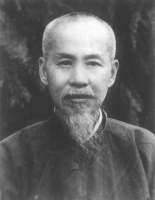| 姓: | 熊 | ||
| 名: | 继智 | ||
| 字: | 子真 | ||
| 网笔号: | 逸翁; 漆园老人; 升恒; 定中 | ||
| 籍贯: | 湖北黄冈县上巴河张家湾 | ||
阅读熊十力 Xiong Shili在百家争鸣的作品!!! | |||
知识之败,慕虚名而不务潜修也;品节之败,慕虚荣而不甘枯淡也。——熊十力名言
生平简介
熊十力(1885-1968),原名继智、升恒、定中,号子真、漆园、逸翁,清光绪十一年(乙酉年)1885年2月18日(农历正月初四日)出生,湖北省黄冈人。晚年号漆园老人,黄冈(今团风)县上巴河张家湾人。著名哲学家,新儒家开山祖师。幼时在家随兄读书,14岁从军,1905年考入湖北陆军特别小学堂,在校期间,加入武昌“科学补习所”、“日知会”等反清革命团体,武昌首义后参加光复黄州,后赴武昌,被任命为湖北军政府参谋。1917年赴广州参加孙中山领导的“护法运动”。失败后,决意专心从哲学研究。先后在武昌文华大学、天津南开中学、北京大学、浙江大学任教。全国解放后,"特别邀请人士"身份参加首届全国政治协商会议,后被选为全国政协、二、三、四届委员。1968年5月23日因病在上海逝世。
著有《新唯识论》、《原儒》、《体用论》、《明心篇》、《佛教名相通释》、《乾坤衍》等书。其学说影响深远,在哲学界自成一体,“熊学”研究者也遍及全国和海外,《大英百科全书》称“熊十力与冯友兰为中国当代哲学之杰出人物”。
熊十力有二女一子:长女幼光,在北京航空学院退休,次女是再光,现在上海居住。其子,曾就读西南联大,后在上海船舶研究所任职,已去世。其子有二子二女,两女孩名分别为"原"、"儒"。而二子各育一女,命名又为"明心"、"明宗";也是后辈对老人的纪念。据说其曾孙女熊明心是上海复旦哲学系硕士生。现免试推荐去德国了。
往事略集
熊十力自幼即与众不同,独具才思而又非常自尊、自信。他曾口出“狂言”道:“举头天外望,无我这般人。”令其父兄诧异不已。十六七岁时,他即四处游学,当他最先读到陈白沙的“禽兽说”时,忽起神解,“顿悟血气之躯非我也,只此心此理,方是真我。”并从中领悟到人生之意义与价值。绝非是趋利避害、去苦就乐等外在满足,而在领悟人生之意义与价值,体识至大至刚之“真我”,以合于天地万物之理。这一觉悟基本上奠定了他以后的治学方向。
辛亥革命时期,熊十力痛感清王朝政治腐朽,民族危机深重,常以范仲淹“先天下之忧而忧”一语置诸座右而自警。在博览群书的过程中,他深迷于“格致启蒙”之类著作,而视六经诸子为士直。且深受明清之际王船山、黄梨洲、顾亭林等大哲之著作以及清末严几道、梁启超、谭嗣同等维新志士之论著的影响,而“慨然有革命之志”,决心为反清而奔走呼号。
1902年,熊氏为策动军队而投湖北新军第三十一标当兵,白天操练,夜间读书,并向报馆投稿,倡导革新现实,救亡图存。此间,他逐渐认识了宋教仁、吕大森、刘静庵、张难先等革命志士,并在1904年共同创建第一个革命团体——科学补习所,秘密宣讲革命思想,倡导反帝反清,救国救民。1906年,熊十力加入日知会,并组织黄冈军学界讲习社,联络各方志士,为发动起义作准备,后因事泄而遭清廷通缉,他只好潜归乡里教书。1911年,他参加了震惊中外的武昌起义,并任湖北督军府参谋。辛亥革命失败后,他又追随孙中山参加护法运动。但由于军阀政客的排挤,孙中山后来被迫离开军政府,护法运动亦宣告失败,这给熊十力以很大打击。他目睹“党人竟权争利,革命终无善果”,内心非常痛苦,常常“独自登高,苍茫望天,泪盈盈雨下”。他根据自己的所历所见,总结出:祸乱之起因皆在于军阀官僚之贪淫侈糜。卑屈苟且,以及国民之昏然无知。于是,他下决心走出政治,“专力于学术,导人群之正见”。他认为救国之根本似乎并不在于革命,而在于学术兴盛,“于是始悟我生来一大事,实有政治革命之外者,痛海以往随俗浮沉无真志,誓绝世缘,而为求己之学”(《十力语要》)。从此以后,熊十力遂决然脱离政界,专心于“求己之学”,以增进国民的道德为己任。这是他一生中最重大的转折。
1920年,熊十力进入南京支那内学院从欧阳竟无大师研习佛学。其间首尾三年,潜心苦修,独具慧心,颇有创获,而生活却艰苦异常,唯一的一条中装长裤,常是洗了之后要等干了才能穿的。1922年,受梁漱溟等人的揄扬与举荐,熊十力被蔡元培聘为北大主讲佛家法相唯识的特约讲师。一到北大,他即打破“师生蚁聚一堂”之学院式教学方式,而采取古代师生朝夕相处,自由随和的书院式教学,力主道德与学问并重,生活与学习一致。在主讲《唯识学概论》的过程中,他对唯识论逐渐由怀疑而至展开批判,并开始构造他独出心裁的“新唯识论”哲学体系。
1932年,竭熊氏十年之力的煌煌巨作《新唯识论》(文言文本)出版,这标志着蜚声中外的“新唯识论”哲学体系的诞生。但此书一出,即刻遭到佛学界人士尤其是内学院师友之群起攻击。其师欧阳阅后痛言:“灭弃圣言,唯子真为尤”,措辞严厉。欧阳弟子刘衡如更著《破新唯识论》对熊氏其书进行系统破斥,指责他“于唯识学几乎全无知晓”,并指斥其书乃“杂取中土儒道两家之义,又旁采印度外道之谈,悬揣佛法,臆当亦尔”。熊十力自不甘沉默,立即应战,并著成《破(破新唯识论)》一书,对刘氏之斥逐一破解。他为自己辩护说,《新》著“义既远离唯识,旨亦上符般若”,认为自己非但没有离经叛道,反而是对佛学的维护和发展,与欧阳等人相反的是,蔡元培、马一浮等人却对此书推崇备至,评价甚高。
蔡元培称熊氏乃二千年来以哲学家之立场阐扬佛学最精深之第一人。马一浮先生更在序言中将熊十力与王弼、龙树并提,称其学识创见乃超越于道生、玄类、窥基等古代佛学大师之上,真可谓推崇至极!
熊十力在为学之余,喜善交学界朋友,与时贤如黄季刚、马叙伦、梁漱溟、胡适之、张东崧、张申府、钱穆、汤用彤、蒙文通、张君劢、冯友兰、金岳霖、朱光潜、贺麟等人,时相过从,切磋学问。尤其是与林宰平、梁漱溟二人曾在一段时间里交往甚密,“无有睽违三日不相晤者。每晤,宰平辄诘难横生,余亦纵横酬对,时或啸声出户外。漱溟则默然寡言,间解纷难,片言扼要。余尝衡论古今述作得失之判,确乎其严,宰平戏谓曰:老熊眼在天上。余亦戏曰:我有法限,一切如量。”
这种诘难攻讦的论学方式,使熊氏受益匪浅,他的许多论点就是在这种辩难中产生和完善的。更有趣的是熊十力与同乡人废名(冯文炳,文学家)的交往,据他回忆说,两人一当相遇,必是口舌相加,每当争论起学术问题来,经常是各不相让,始则面红耳赤,大叫大嚷,继则扭成一团、拳脚相加,最后是不欢而散,然过一二日再聚时,则又谈笑风生,和好如初,如此狂怪而又豁达大度之人,真可谓古之罕有,今亦绝无!
抗日战争爆发后,熊十力并没有随北大南迁昆明,而是先回原籍黄冈,继则避难四川,任教于马一浮主持的乐山复性书院,讲授宋明理学。此时的熊十力,虽身处后方,却痛感外侮日迫,族类益危,常因想起沦陷区同胞之苦辱而禁不住失声痛哭。为此,他撰写了《中国历史讲话》一书,大讲汉、满、蒙、回、藏五族同源,意在为各民族团结一心、共同抗日提供理论与历史依据。
1943年,他接到北大校长蒋梦麟聘他为文学院教授的聘书,并被特准可暂时不到校上课。此间,因与马一浮先生学术见解不合而移居梁漱溟在重庆北碚的勉仁书院。值此民族危亡之秋,熊十力将其满腔真情都倾注在中华文化的存亡绝续之上。
他认为,一个民族要生存下去,必须要有自己的哲学,自己的文化。为此,他开始投入更多的精力研究儒家学说,并写成《读经示要》等关于儒学的著作。他对胡适等人“全盘西化”的主张多有批判,但又不沉迷于圣贤经典之中,而是对传统儒学作较彻底的反思,并吞吐百家,融铸儒佛,独创一思辨缜密的中国化的哲学,1944年,熊氏《新唯识论》语体文本杀青付梓,由重庆商务印书馆作为中国哲学会中国哲学丛书甲集之第一部著作出版。此书是熊氏最主要的哲学著作,它标志着熊十力哲学思想体系的完全成熟。如果依据文言文本尚可把熊氏看成“新佛家”学者的话,那么,以语体文本为界,则应当视其为“新儒家”学者。此书与稍后出版的《十力语要》、《十力语要初续》等书一起,构成了熊十力新儒家哲学思想的主要内容。
1948年,国共战事日激,国民党节节败退。是年秋天,熊十力移住广州郊外化龙乡黄民庸家。全国解放前夕,熊氏曾彷徨不安,他本意很想回北大或老家湖北的武汉大学,专心治学,但又心存疑虑,曾动念去印度或港台。但令他万万没有想到的是,共产党并没有忘记他这位时贤大哲。
1949年10月在广州解放之后第十天,他的老朋友董必武、郭沫若即联名电邀熊先生北上,共商国是,并同时关照沿途各级政府,热情接待,妥善安排。次年3月,熊十力抵京,政务院秘书长齐燕铭到车站迎接。追往思昔,想起 1937年“七·七”事变后扒煤车逃离北平而路遇暴雨,浑身湿透的凄景,熊十力真是百感交集,思绪翻滚。他由此确信:中国人民真的站起来了!祖国任人宰割的历史从此将一去不复返!
熊十力抵京后,由政府安排住在什刹海后海大金丝套的一所小四合院,直到1954年离京为止,此处风景宜人,且毗邻多为旧日好友如梁漱溟、林宰平、张申府、贺麟等,而旧时弟子亦时常登门拜谒;同时,党内外许多高级人士如董必武、郭沫若、林伯渠、徐特立、李济深、陈铭枢、艾思奇等新朋旧友也常来探望,这使熊先生心情甚为舒畅。在这难得的安定环境中,不但继续著书立说,先后写就《与友人论张江陵》、《与友人论六经》、《新唯识论》删定本和《原儒》上卷等,而且他还非常关心新中国的文化建设,多次致函毛泽东、周恩来、董必武等中央领导人,为新中国的文化建设出谋划策。1954年,因各种原因,熊十力渐感孤独,同时亦难耐北方冬天寒冷干燥的气候,遂于是年底移居上海。熊十力定居上海后,仍笔耕不辍,1956年完成了《原儒》一书的下卷,并将上下卷同时印刷出版。全书共33万余字,重点发掘了儒学中有价值的部分,并按照自己的理解,以“六经注我”的精神,重新阐释了儒学经典和儒学史。这一巨著是熊十力作为新儒家学者的又一重要成果,继此书之后,熊十力又以超凡的毅力和速度完成了《体用论》、《明心篇》、《乾坤衍》等著作的撰写,前后共8种,凡130万言,真可谓老骥伏枥、壮心不已!
然而,在狂飚数起的中国当代社会中,和绝大多数中国知识分子一样,熊十力亦不可能完全置身世外,埋头书斋。他的著作被当作“反动复古主义”而遭到批评,先前的老友和学生也多数被打倒、批判,其余的也发发自危。在左倾之风愈刮愈紧的日子里,熊十力愈来愈感到孤独和迷茫。他明显地衰老了,目光不再如以前那般炯炯有神,谈吐不再像以前那般潇洒自如,情绪也不再像以前那么热烈激昂了,他常独自一人端坐桌边,面前放上一叠白纸,手中握枝秃笔,神情专注,似有万千心事诉诸笔端,却又无从下笔,良久呆坐。唯与古圣先贤如孔子、王阳明、王船山等心仪神交,稍可慰藉。他对“左”的一套极为反感,却又无可奈何。在万般悲苦中,他曾作一联寄友人:“衰年心事如雪窖,姜斋千载是同参。”足可表达其晚年心境之凄谅!
左倾之风愈演愈烈,批斗运动亦步步升级,随之而来的就是那场旷古绝后的人间浩劫。1966年夏,当熊十力在《人民日报》上看到《横扫一切牛鬼蛇神》一文时,伤感至极,他痛彻地感到:不但他的书无法再写下去,更悲惨的是,连同他所承继的国学亦将濒于绝灭,国家民族将陷入苦难的深渊。家被抄了,人被批斗,人妖颠倒,是非不分,天昏地暗,万物萧杀。处此艰厄之境,他的精神再也无法承受而渐至错乱。他不断地给中央领导人写信,硬让家人寄出去,还经常写很多小纸条,甚至在裤子上,袜子上都写着对“文革”的抗议。他常常穿着一件褪了色的友布长衫,扣子全无,腰间胡乱地扎一根麻绳,独自一人到街上去或公园里,跌跌撞撞,双泪长流,口中念念有词“中国文化亡了!”“中国文化亡了!”然而,街市熙攘,人皆自危,没有人来理会他,也没有人对他口中所念有丝毫的惊异。于是,这位旷世奇哲和千千万万的文化人一样,被残酷地淹没在一个残忍地践踏文化的所谓“文化大革命”的浊流之中。
1968年5月23日,熊十力因患肺炎而心力衰竭,在上海虹口医院病逝,享年84岁。
哲学观点
熊十力主要的哲学观点是:体用不二、心物不二、能质不二、天人不二。他 所谓“体”是“心体”、“性体”,即人的生命存在的本体、宇宙万物之本根及其生生不息的源头活水,在一定意义上也是道德的本体和道德的主体。所谓“体用不二”,也就是肯定生命的意义和人生的价值,是为了在物欲横流的世界重新寻找“人生本质”和“宇宙本体”。熊氏认为,吾人与天地万物所同具的仁心本体,内蕴着极大的力量,可以创造出、生化出整个人文世界。他高扬了仁心本体刚健、创生的特质,实际上是以积极的人生态度、生命意识和人本精神去面对世界,创造世界,同时又主张不被人们创造出来的物质世界和人文建制所异化、所遮蔽,以致忘 却、沦丧了人之所以为人的根蒂。
熊十力是我国现代哲学史上最具有原创力、影响力的哲学家。他奠定了现代新儒学思潮的哲学形上学之基础。他的“体用不二”之论,成为整个当代新儒学思潮“重立大本、重开大用”和“保内圣,开新外王”的滥觞,亦成为这一思潮的基本思想间架。熊十力的全部工作,简要地说,就是面对西学的冲击,在儒学价值系统崩坏的时代,重建儒学的本体论,重建人的道德自我,重建中国文化的主体性。他的学生唐君毅、牟宗三、徐复观正是在他的精神感召之下,沿着他开创的精神方向和他奠立的形上基础而加以发皇、扩展、深化、扬弃的。学界把他们师弟视为现代新儒学思潮的中坚。
综观熊十力哲学,大致经历了由融儒入佛到儒佛同参,再到融佛入儒、归宗儒学的演进历程。其一生为学,融贯中西,平章华梵,摒弃陈说,绝少依傍。其“新唯识论”哲学思想体系建构宏伟,构思奇巧,富有创发,独具特色。他是新儒学发展历程中,继梁漱溟之后,极具开创性的一代大师。其哲学思想虽有不少局限,但他以其广阔的文化视野,独具的哲人慧思,提出并力求解决的人生问题与文化问题,诸如人的终极关切、人与自然的关系、人的困惑和疏离等,仍是人类现在乃至以后所面临而必须解决的问题,而他凭着对生命存在的独特体验,所作出的对人的内在的道德自觉、价值自觉、文化自觉的阐扬,又为人类开创了一条探寻价值的新路,而具有普遍的世界意义。正因为如此,熊十力的哲学思想才在海内外学术界引起越来越广泛的注意和重视。
治学精神
我们看近现代主流学术,乃是形成了一种社群运作规程的科学活动。其本质上是科学性的、社会化的。虽然学术观点尽可以不必相同,但总有共同的纪律,共同的仪式,共同的关切点,共同的信念,甚至共同的刊物阵地、学会组织或师友网络,带领着、推动大家做学问,你来我往地解决问题,开展学术,形成大致相同的理路与处理问题的方法,形成知识阶层存在的社会科层化、有序化与自律化机制。
再者,学术人作为一种生活方式一旦形成,有关生活的种种因素自然有时也不免渗入理论的兴趣或知性的兴趣,甚而主宰这些兴趣。利害的权衡、权力的攫取、声名的诱惑,甚而利禄的直接导入,都难免有时使学术人在这个网络结构中,以学术为手段,为取胜而研究,为占地盘而著书立说。如此一路研究下来,著书立说下来,久而久之,亦能成为一大宗师,成一大格局。说得通俗一点,即叫做“吃学术饭”。
又有一种学术,也讲规则,讲学理,同时也对于时代问题有相当的回应与投入的关切。只是,他们的关切,或他们的“问题意识”,端赖外缘条件给他们提出、给他们刺激,他们就像一些“发烧友”或“应声虫”,一个时期这样,一个时期又那样。这难说是真实的 “问题意识”与“存在感受”。因为这些东西不是从他们的生命中自本自根地长出来的,因而这种学术缺乏长时段的大愿力,缺少了一份诸如熊十力所说的“穷深研几”之功,说到底,乃是缺乏熊先生所说的“孤往精神”。
熊著《十力语要》说:“人谓我孤冷。吾以为人不孤冷到极度,不堪与世谐和。”他将王船山与李恕谷拿来作一对照:“船山正为欲宏学而与世绝缘。百余年后,船山精神毕竟灌注人间。……然则恕谷以广声气为宏学者,毋亦计之左欤。那般虏廷官僚,胡尘名士,结纳虽多,恶足宏此学。”熊氏认为,“恕谷忍不住寂寞”的背后,其实骨子里正是“实伏有驰鹜声气之邪欲而不自觉。”所以“恕谷只是太小,所以不能如船山之孤往。……凡有志于根本学术者,当有孤往精神(卷四)”。
十力先生提倡“孤往精神”,正是对于他的那个时代痛下针砭。他又说:“中国学人有一至不良的习惯,对于学术,根本没有抉择一己所愿学的东西。因之,於其所学,无有甘受世间冷落寂寞而沛然自足不顾天不顾地而埋头苦干的精神於中的生趣。如此,而欲其学术有所创辟,此比孟子所谓缘木求鱼及挟泰山以超北海之类,殆尤难之又难。吾国学人,总好追逐风气,一时之所尚,则群起而趋其途,如海上逐臭之夫,莫名所以。曾无一刹那,风气或变,而逐臭者复如故。此等逐臭之习,有两大病。一、各人无牢固与永久不改之业,遇事无从深入,徒养成浮动性。二、大家共趋于世所矜尚之一途,则其余千途万途,一切废弃,无人过问。此二大病,都是中国学人死症。(下文举例如前清考据之风、新文学、科学主义等,略)逐臭者,趋时尚,苟图媚世,何堪恬淡。随众势流转,侥幸时名,何堪寂寞。逐臭之心,飘如飞逢,何能专一。自无抉择之习,唯与俗推移。无所自持,何能恒久。故一国之学子,逐臭习深者,其国无学,其民族衰亡徵象已著也。而中国人喜逐臭,而不肯竭其才以实事求是,喜逐臭,而不肯竭其才以分途并进,喜逐臭,而不肯竭其才以人弃我取,此甚可忧”(卷一)。
熊先生这番话,细细想来,亦不啻为我们这个时代一付清醒剂。“惊于其声誉、震于其权威、炫于社会上千百无知之徒之展转传说,遂从而醉心焉,此愚贱汗鄙之尤。少年志学,宁当尔哉。天下唯浮慕之人,最无力量,决不肯求真知。吾不愿汝为此也。汝好名好胜,贪高骛远,不务按部就班工夫。一日不再晨,一生不再少,行将以浮慕而毕其浮生,可哀也哉(卷四)”。今天真正有志于学的青年,对于这一番告诫,当反诸己,思之再三。
学术独立与自由,说到底,是一个内心的自由问题。中国传统的辞语叫做“自得”,义涵似长。在解构了外在的教条主义权力言说方式之后,另有多元的价值与多元的声音,有时竟汇成一场嘈杂的鸡尾酒会。会中人各持酒杯、自成圈子。你肯不肯向隅而坐?
友人追忆
一九一九年我任北京大学讲席时,忽接得熊先生从天津南开中学寄来一明信片,略云:你在《东方杂志》上发表的《究元决疑论》一文,我见到了,其中骂我的话却不错;希望有机会晤面仔细谈谈。不久,各学校放暑假,先生到京,借居广济寺内,遂得把握快谈——此便是彼此结交端始。
事情的缘起,是民国初年梁任公先生主编的《庸言》杂志某期,刊出熊先生写的札记内有指斥佛家的话。他说佛家谈空,使人流荡失守,而我在《究元决疑论》中则评议古今中外诸子百家,独推崇佛法,而指名说:此土凡夫熊升恒……愚昧无知云云。
因此,见面交谈,一入手便是讨论佛氏之教,其结果便是我劝他研究佛学,而得他同意首肯。不多日,熊先生即出京回德安去了。
一九二0中(民国九年)暑期我访问南京支那内学院,向欧阳竟无大师求教,同时即介绍熊先生入院求学,熊先生的佛学研
究由此开端。他便是从江西德安到南京的。附带说,此次或翌年,我还先后介绍了王恩洋、朱谦之两人求学内院。朱未久留即去;王则留下深造,大有成就,后此曾名扬海外南洋云。
我入北大开讲印度哲学始于一九一七年,后来增讲佛家唯识之学,写出《唯识述义》第一第二两小册。因顾虑自己有无知妄谈之处,未敢续出第三册。夙仰内学院擅讲法相唯识之学,征得蔡校长同意,我特赴内学院要延聘一位讲师北来。初意在聘请吕秋逸(徵,水旁)君,惜欧阳先生以吕为他最得力助手而不肯放。此时熊先生住内学院约计首尾有三年(一九二0——一九二二年),度必饫闻此学,我遂改计邀熊先生来北大主讲唯识。
岂知我设想者完全错了!错在我对熊先生缺乏认识。我自己小心谨慎,唯恐讲错了古人学问,乃去聘请内行专家;不料想熊医生是才气横溢的豪杰,虽从学于内学院而思想却不因袭之。一到北大讲课就标出《新唯识论》来,不守故常,恰恰大反乎我的本意。事情到此地步,我束手无计。好在蔡校长从来是兼容并包的,亦就相安下去。
熊先生此时与南京支那内学院通讯中,竟然揭陈他的新论,立刻遭到驳斥。彼此论辩往复颇久,这里不加叙述。我自审无真知灼见,从来不敢赞一词。
计从一九二二年熊先生北来后,与从游于我的黄艮庸王平叔等多人,朝夕同处者历有多年。一九二四年夏我辞北大,应邀去山东曹州讲学,先生亦辞北大同往;翌年我偕诸友回京,先生也是同回的。居处每有转移,先生与我等均相从不离,其事例不必悉数。然而踪迹上四十年间虽少有别离,但由于先生与我彼此性格不同,虽同一倾心东方古人之学,而在治学谈学上却难契合无间。先生著作甚富,每出一书我必先睹。我读之,曾深深叹服,摘录为《熊著选粹》一册以示后学。但读后,心有不谓然者复甚多,感受殊不同。于是写出《读熊著各书书后》一文甚长,缕缕陈其所见!
如我所见,熊先生精力壮盛时,不少传世之作。比及暮年则意气自雄,时有差错,藐视一切,不惜诋斥昔贤。例如《体用论》、《明心篇》、《乾坤演》,即其著笔行文的拖拉冗复,不即征见出思想意识的混乱支离乎。吾在《书后》一文中,分别的或致其诚服崇敬,又或指摘之,而慨叹其荒唐,要皆忠于学术也。学术天下公器,忠于学术即吾所以忠于先生。吾不敢有负于四十年交谊也。
一九八三年四月二十三日于北京 作者:梁漱溟
他人评说
熊十力先生是一代大哲、现代新儒家学派的开创者。他一生著述丰富,生前出版的著作单行本就有二十余种,除了以《新唯识论》为代表的阐发自己融摄儒释的哲学体系的著作以外,还包括早期的佛学著作、书信语录集、政治历史哲学、思想学术史方面的著作。熊先生生前陆续出版的著作单行本系列即命名为“十力丛书”。此次世纪文景公司与上海书店出版社联合出版熊先生著作系列,仍沿用“十力丛书”的旧名,以示为完成熊先生的夙愿。本次出版由熊先生的再传弟子、著名学者罗义俊先
生担任学术指导,在此前各种版本的基础上重新进行了点校。并且得到了著名学者王元化先生的大力支持,王先生为丛书作了总序。此次出版将分批陆续全面推出熊著单行本,首批出版五种:《佛家名相通释》、《十力语要》、《十力语要初续》、《韩非子评论与友人论张江陵》、《存斋随笔》。
一
一九六二年秋,我持韦卓民先生介绍信,往淮海中路二六八号拜见十力先生。去前,卓民先生嘱告:“近年来,十力先生谢客来访,他脾气古怪,不知见不见你。”当我走上公寓西侧一座黄色小楼,在十力先生门上看到贴着一张信笺,纸已褪色,字墨尚浓。大意说,本人年老体衰,请勿来访。其中说到自己的身体情况十分具体,记得有面赤、气亏、虚火上延之类的话。
我怀着惴惴不安的心情敲了几下门,开门的是一位六十上下的人。这就是当时正为他誊写《乾坤衍》的封先生。他把我延至客厅,即持介绍信入里间。等候了二三分钟,十力先生从隔壁走来。他的身材瘦弱,精神矍铄,双目奕奕有神,留有胡须,已全白,未蓄发,平顶头,穿的是老式裤褂。我表示了仰慕之意,他询问我在何处工作,读什么书等等。这天他的心情很好。他的态度柔和,言谈也极儒雅,声调甚至近于细弱。当时我几乎与人断绝往来,我的处境使我变得很孤独。我觉得他具有理解别人的力量,他的眼光似乎默默地含有对被侮辱被损害者的同情,这使我一见到他就从自己内心深处产生了一种亲和力。这种感觉似乎来得突兀,但我相信它。在我们往来的近三年内,我从未谈过自己的遭遇,他也从未询问过。直到他去世十多年后,我才从他的哲嗣世菩夫妇那里得悉,十力先生对我的坎坷经历和当时的处境十分清楚,并且曾为之唏嘘。摘自一九九一年所写《熊十力二三事》
二
我是从我个人接触来谈自己的感受,我并不想以此推翻别人的说法,如说十力先生性格怪僻,脾气不好等等。平心生前就向我提到一些事,我想他说的是事实。十力先生自己也向我讲过,他在四川复性书院讲学时和马一浮发生的一次争吵,尽管他们是相契的朋友,马一浮还曾以蠲叟别号为他所撰的《佛家名相通释》签署,为《新唯识论》写序。十力先生师友弟子多称他性格狂放,意气自雄,认为他具有一种慑服人的气概。他在自己著作上署名“黄冈熊十力造”,颇引起一些议论,因为在印度只有被尊为菩萨的人才可以用这说法,据传他也曾经自称“熊十力菩萨”。他在论学时往往意气风发,情不自禁。有一次他与张东荪论学,谈得兴起,一掌拍在张的肩上,张逡巡后退。诸如此类传说,不一而足,使他在人心目中成为一个放达不羁的古怪人物。但他也有亲切柔和、平易近人的一面,大概由于太平凡罢,很少为人述及。我以为不揭示这方面,就难以显示他的完整人格。
我经十力先生允诺后,几乎每周走访一次。他身上有些神秘的东西。他在著作中曾记述,民国六年,他自武昌赴荆襄,参与守军独立。事败,辗转军中,七年入粤。一日午睡,忽梦他的五弟继刚陈尸在床,他不禁抚遗体痛哭,醒而泪痕犹湿。后离军返乡,始知五弟确已去世。他认为梦是预兆休咎的,不能尽以变态心理去说明。我探访他不久,有一次,他很认真地给我看相,可能他把这当作识人的一种方法。我觉得他的神秘主义是和儒家思想有距离的。
我曾向他请教佛学,这时他已由佛入儒。在他起居室内,有三幅大字书写的君师帖。一居中,从墙头直贴到天花板上,上书孔子之位。一在右,从墙头往下贴,上书阳明先生。一在左,也从墙头往下贴,上书船山先生。他听我要学佛学后说:“你学佛学做什么?现在没有人学这个了。”据我当时理解,他并不是非薄佛学,而是对我这种学不干时的态度有所感慨。但他是随和的,同意我向他请教,并约定用通信方式笔谈。摘自一九九一年所写《熊十力二三事》
三
十力先生在六十年代初,自称晚年已由佛入儒,对于阳明、船山二王之学,最为服膺。那时他的身体已很虚弱,他在写给我的一首诗中曾说到自己“衰来停著述,只此不无憾”。其实当时他并未停止写作。我每次去看他,都在他的书桌上见到一叠叠经过大量涂抹删改的稿纸。这就是后来由中国科学院影印出版的《乾坤衍》。我认识他以前,还在新华书店科技门市部见到正在发售的他的另一部著作《原儒》。这两部书都是研究儒学的。他的佛学著作是早年写的,解放后似乎并未重印过。依我的浅见,他可以算得上是“五四”后老一代佛学专家中屈指可数的几位代表人物之一。他和汤用彤先生交谊颇厚,两人都以佛学名家。汤著《汉魏两晋南北朝佛教史》曾引十力先生就鸠摩罗什赠慧远偈所作的诠释。我不知道此文见于十力先生何书,曾请问过他。据他说,这段文字不是引自他的著作,而是应汤先生所请托,为汤先生所写的。从这件事来看,可见汤先生对他的佛学造诣是很器重的。(作者:王元化)
著作目录
《与友人论张江陵》(熊十力,撰)
《新唯识论 : 语体文本》(熊十力,著) (中华书局 1944)
《十力语要初续》(熊十力,撰) (东升印务局 1949)
《明心篇》(熊十力著) (龙门联合书局 1959)
《乾坤衍》(熊十力造) (中国科学院复印] 1961)
《中国哲学思想论集,现代篇》(熊十力著/唐君毅著/殷海光著) (牧童出版社 1978)
《体用论》(熊十力,著) (台湾学生书局 1983)
《明心篇》(熊十力,著) (台湾学生书局 1984)
《新唯识论》(熊十力著) (中华书局 1985)
《佛家名相通释》(熊十力著) (中国大百科全书出版社 1985)
《论张江陵》(熊十力撰) (文明书局 1988)
《论六经》(熊十力撰) (明文书局 1988)
《摧惑显宗记》(熊十力著) (台湾学生书局 1988)
《孔子文化大全.第2种,论著类》(苗枫林主编/熊十力著) (山东友谊出版社 1989)
《熊十力集》(熊十力, 著) (群言出版社 1993)
《存斋随笔》(熊十力, 著) (上海远东出版社 1994)
《体用论》(熊十力, 著) (中华书局 1994)
《现代新儒学的根基 : 熊十力新儒学论著辑要》(熊十力,著) (中国广播电视出版社 1996)
《中国现代学术经典,熊十力卷》(刘梦溪主编/熊十力, 著) (河北教育出版社 1996)
《十力语要》(熊十力著) (中华书局 1996)
《十力语要》(熊十力,著) (辽宁教育出版社 1997)
《大海与众沤 : 熊十力集》(熊十力著) (上海文艺出版社 1998)
《熊十力学术文化随笔》(熊十力著)(中国青年出版社 1999)
《熊十力全集》(熊十力, 著) (湖北教育出版社 2001)
熊氏年表
1885年 1岁 夏历正月生于湖北省黄冈县上巴河张家湾。
1892年 8岁 家境贫困,为邻家牧牛,闲时随父在家识字。
1894年 10岁 入父亲掌教之乡塾读书,初习五经章句,次及史。
1900年 16岁 长兄仲甫送先生从学于邻县圻水何昆阁门下。受其影响,喜读晚明诸先生书,尢爱船山书,并兴救国之志。先生从学何先生仅半年,因家贫及同学忌讽,辍学归家。
1902年 18岁 与王汉、何自新共游江汉,同谋革命。入武昌新军凯字营第31标为兵卒,谋运动军队,联络党人。
1905年 21岁 由行伍考入湖北新军特别学堂,仍密谋革命。
1906年 22岁 与刘子通等联合军学界有志之士,成立黄冈军学界讲学社。由何自新介绍加入日知会。以后数年曾参与武昌首义、二次护国讨袁运动。
1918年 34岁 深感“党人绝无在身心上做工夫者,如何拨乱返正?”又自度非事功之才,遂志学术一途。是年,将1913年至1918年间,读书札记,书信,杂论,及为友人所撰传记、序文共25篇合刊为《心书》自印出版。
1920年 36岁 由梁漱溟推荐赴南京支那内学院,从学欧阳竟无大师。次年草撰《唯识学概论》初稿。
1922年 38岁 应蔡元培之邀,赴北京大学,讲授唯识学。
1923年 39岁 10岁,唯识学讲稿始由北京大学出版组正式出版,名《唯识学概论》。
1924年 40岁 秋初,随梁漱溟先生赴山东曹州省立第六中学任教。
1925年 41岁 春,应石瑛先生邀,赴武昌大学执教。秋,因武大校长易人,又返回北大。为讲授因明学之需,自秋涉冬删注窥基之《因明入正理论疏》,年底事毕。
1926年 42岁 三月,开始改写《唯识学概论》。七月,《因明大疏删注》,由上海商务印书馆出版发行。因用思过劳,始患神经衰弱之症。
1927年 43岁 年初,移南京中央大学休养,常与汤用彤、李石岑等论学。后移往杭川养病。
1928年 44岁 应汤用彤之邀,赴南京中央大学哲学系作短期讲学。时唐君毅就读中大,始从游于先生。
1930年 46岁仍住杭州广化寺疗养。经浙江省图书馆馆长单不庵介结,结识马一浮。《唯识学概论》经重新修订,易名《唯识论》出版。由弟子高赞非、张立民记录校订先生在 1924年秋至1928年秋四年间,与朋友、学生论学之语及书札,编辑成册,名为《尊闻录》自印出版,分赠好友。
1932年 48岁 10月,《新唯识论》(文言本)由浙江省立图书馆出版发行。马一浮作序并题答。11月,返回北大继续教授唯识学。时牟宗三就读北大,始从学先生。常与张申府、张岱年兄弟、林宰平、汤用彤、李证刚、郑天挺、陈政、罗庸、罗常培等往来论学。12月,内学院年刊《内学》第六辑刊登刘定权(衡如)的《破新唯识论》一文,欧阳竟无师为之作序。
1933年 49岁 1月,太虚法师于《海潮音》14卷1期发表《略评新唯识论》一文。2月,撰成《破破新唯识论》,酬正内学院师友,由北大出版部印行。8月17日,在《大公报》发表《循环与进化》一文。秋,周叔迦的《新唯识三论判》一书,由北平直隶书局出版,对《新唯识论》,《破新唯识论》,《破破新唯识论》提出批评。
1934年 50岁 4月8日,在《独立评论》上发表《无吃无教》一文。6月10日,又发表《英雄造时势》一文。9月20日,在《大公报》发表《易佛儒》一文。时与钱穆、蒙文通、张孟劬、张东荪昆仲相过从。
1935年 51岁 1月,在《史学》(北大出版)一期发表《请诰授奉直归州学正传雨卿先生传》。6月,于《安雅学刊》一期发表《读经》一文。10月,于《文化建设》1卷9期发表《文化与哲学》一文。28日,于《大公报》发表《答伍庸伯》一文。8月30日,就中国哲学会成立,在《大公报》上发表《为哲学年会进一言》文,提出中国亟需一种新哲学。10月,由弟子云颂天、谢石麟存录整理先生在1932年冬至1935年秋,三年间与友人论学书及笔札的《十力论学语联略》一书,由北京出版社出版发行。
1936年 52岁 2月1日,在《中心评论》第2期发表《答朱进之》文;21日发表《论不朽书》。3月20日,在《文哲月刊》1卷6期发表《关于宋明理学之性质》。8月,始撰写《佛学名词释要》,及秋完稿,由北大印行若干本。12月,在《哲学评论》7卷2期上发表《佛学名词释要》中的28条词释。始用《佛家名相通释》一名。
1937年 53岁 2月,《佛家名相通释》由北大出版组出版发行。是年,于湖南郴县创辨“十力中学”,由弟子燕大明主持。
1938年 54岁 春,由鄂入川。夏,为诸生开讲中国历史,弟子记录整理成册,名《中国历史讲话》,由中央陆军军官学校石印若干册。冬,指导钱学熙翻译《新唯识论》文言本为语体。拟再译成英文做准备。
1939年 55岁夏,马一浮主持复性书院于乐山创辨,应邀担任讲席。9月17日,撰《复性书院开讲示诸生》。未几,与马一浮相处不和,离开复性书院,时武汉大学迁至乐山,应朱光潜之邀,前往作短期讲学。冬,韩裕文续接钱学熙翻译《新唯识论》,完成转变章,至是,《新唯识论》(语文体)上卷脱稿。
1940年 56岁 夏,《新唯识论》(语体文本)上卷,由吕汉财资印二百部。是年,梁漱溟创办勉仁书院于北培,约先生前往主讲。
1941年 57岁 4月,周封歧资助印行《十力语要》卷二四百部。秋,由先生自己翻译的《新唯识论》(语体文)中卷脱稿。10月,赴北培勉仁书院担任主讲。
1942年 58岁 1月,《新唯识论》(语体文本)上,中两卷由勉仁书院哲学组出版。6月,《论周官成书年代》一文发表在《图书季刊》第2期。《思想与时代》刊物第12期起,连续发表《论体相》、《论玄学方法》、《儒家与墨法》、《谈生灭》等文。
1943年 59岁 春,《新唯识论》(语体文)下卷完成,将上、中卷合为一书,并做一些改动。
1944年 60岁 1月,在《哲学评论》8卷5期刊载《新唯识论问答》一长文。2月,始撰写《读经示要》,11月完稿。3月,《新唯识论》(语体文本)上、中、下三卷由重庆商务印书馆出版发行。
1945年 61岁 9月,在《中国文化》第一期发表《论汉学》一文,12月,《三民主义》半月刊7卷8期上发表《说食》一文。
1946年 62岁 4月,回北京大学执教。夏,孙颖川主持黄海化学社,特邀请先生回蜀负责哲学部工作。发表《中国哲学与西洋科学》讲词。刊于《黄海化学社附设学研究部特辑》嘱王星贤整理抗战期间的信函短札,成《十力语要》卷三。
1947年 63岁春,由重庆返回北大。6月,《学原》1卷2期发表《答牟宗三问格物致知书》。《哲学评论》十卷五期发表《与柏特教授论哲学之综合书》。《龙门》1卷4期发表《论关老之学书》。7月,读《大智度论》,并作《读智论钞》。《东方与西方》1卷4期发表《读智论偶抄》。8月,就《学原》1卷4期发表《略说中西文化》。《哲学评论》10卷6期发表《论本体书与说理书》。《龙门》1卷6期发表《读汪大绅绳荀》。《世间解》第3期至第7期连续发表《读智论抄》。10 月,“十力丛书”之《新唯识论》(语休文本)和《十力语要》(四卷本)先后印行。
1948年 64岁 2月,应聘至浙江大学讲学。5月,《学原》1卷12期发表《论事物之理与天理:答徐复观》。2卷1期发表《略谈新论旨要》(答牟宗三)。冬,南下广州,命黄艮庸作《新论平章儒佛诸大问题之申述》一长文,答辨印顺法师《评熊十力的新唯识论》文。
1949年 65岁 1月,辑成《十力语要初续》,12月由香港东升印务局印行。2月,《读经示要》由正中书局重版发行。
1950年 66岁 1月,《韩非子评论》在《学原》3卷1期直发表。仲秋,撰成《与友人论张江陵》一书。11月,《摧惑显宗记》由大众书局印行。是年,应董必武、郭沫若之请,由广州途经武汉返回北京。
1951年 67岁 5月,《论六经》一书完稿。
1952年 68岁 中秋,作《新唯识论语体文本壬辰删定记》。
1953年 69岁 冬,《新唯识论》(壬辰删简本)印行。
1954年 70岁 春,始起草《原儒》上卷,至中秋脱稿。10月,回到上海定居。
1955年 71岁 夏,作《六经是孔子晚年定论》一长文,10月,始起草《原儒》下卷。
1956年 72岁 夏初,《原儒》下卷脱稿。12月,《原儒》上、下两卷,由上海龙门联合书局正式出版发行。
1957年 73岁 冬, 《体用论》脱稿。
1958年 74岁 4月,《体用论》由上海龙门联合书局石印出版。5月,始起草《明心篇》,初冬完稿。
1959年 75岁 4月《体用论》由上海龙门联合书局出版。夏,开始撰写《乾坤衍》。《唐世佛学旧派反对玄奘之暗潮》一文收放《中国哲学史论文初集》。
1960年 76岁 继续撰写《乾坤衍》,体弱多病,写作艰难。
1961年 77岁 1月,《乾坤衍》完稿,秋由科学出版社印行。
1963年 79岁1月,开始起草《存斋随笔》,12月完稿。书稿由封用拙誊正,拟影印出版而未果。
1964年 80岁 春夏之交,大病。
1965年 81岁 董必武推介先生读《实践论》、《矛盾论》、《费尔巴哈和德国古典哲学的终结》,并言:“兄治哲学之背景,不仅弟理解,吾党之士亦多能理解也。”8月,作《先世述要》,未完稿。
1966年 82岁 文革爆发,寓舍查封,身心俱受摧残。
1968年 84岁 春夏之际,患肺炎住院,病渐愈,乃返家。5月24日,心力衰竭;9时许与世长辞。
Xiong Shili (Chinese: 熊十力; pinyin: Xióng Shílì; Wade–Giles: Hsiung Shih-li, 1885 – May 23, 1968) was a Chinese essayist and philosopher whose major work A New Treatise on Vijñaptimātra (新唯識論, Xin Weishi Lun) is a Confucian critique of the Buddhist Vijñapti-mātra "consciousness-only" theory popularized in China by the Tang-dynasty pilgrim Xuanzang.
Xiong is widely regarded as the thinker who laid down the basis for the revival of Confucianism during the twentieth century, and the main voice in contemporary Chinese philosophy who called for a revival of the Confucian dao. He felt it could provide a guide for the country during its tumultuous period following the May Fourth Movement in 1919.:127 He felt that national survival was predicated on a sense of community, which in turn could only come from trusting commitments from the people involved. He believed that the most urgent task for the educated elite in China was to raise the cultural awareness and sensitivity of the people that the clash between the West and China was not solely a clash of economic strength and military might, but also a conflict between basic human values.:248 While he led a fairly secluded life throughout his career as a teacher and his association with the academic community did not begin until he was in his late thirties, his views have influenced scholars to this day.
